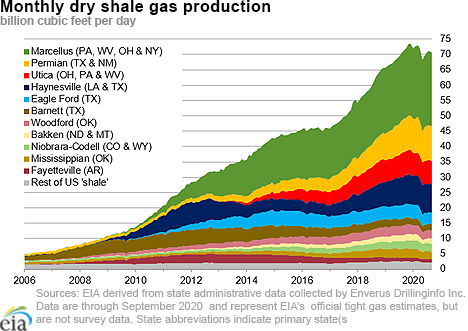In the News:
EIA forecasts higher-than-average residential natural gas consumption this winter
According to October’s Short-Term Energy Outlook, EIA forecasts residential natural gas consumption for the 2020–21 winter season (October–March) to average 21.1 billion cubic feet per day (Bcf/d), an increase of 1.1 Bcf/d (5.3%) from the 2019–20 winter average. The higher expected residential consumption of natural gas this winter is primarily related to forecasts for colder temperatures this winter than last winter.
Last winter was notably warm, averaging 572 heating degree days (HDDs), compared with the 10-year average of 603 HDDs. The warmer-than-normal winter temperatures contributed to residential natural gas consumption averaging 20.0 Bcf/d last winter, the lowest since the 2016–17 winter. Based on weather forecasts from the National Oceanic and Atmospheric Administration (NOAA), EIA expects the 2020–21 winter to have 602 HDDs, which is only slightly higher than the 10-year average and about 5% higher than last winter. NOAA forecasts cooler-than-normal temperatures this winter in the North and warmer-than-normal temperatures in the South, which is, in part, due to the La Niña weather pattern.
Changes in consumer behavior due to COVID-19 mitigation efforts will also contribute to higher residential consumption of natural gas this winter. EIA expects work-from-home and virtual schooling policies to affect winter residential consumption because with more people home during the day, residential space heating demand will increase compared with last winter, prior to the COVID-19 pandemic.
Nearly half of all homes are primarily heated with natural gas. According to EIA’s Winter Fuels Outlook released on October 6, the average price of residential natural gas this winter for homes that primarily use natural gas for heating is expected to average $9.55 per thousand cubic feet (Mcf), down from $9.73/Mcf last winter. The lower average residential price of natural gas reflects generally lower natural gas spot prices in 2020. However, changes in natural gas spot prices generally pass through to residential consumers with considerable lag because some state utility commissions set the rates that utilities can charge for natural gas deliveries a year or more in advance. In addition, residential natural gas prices include charges not linked directly to spot natural gas prices, such as customer and distribution charges, which help utilities cover operational costs.
Despite lower prices, EIA forecasts higher residential natural gas consumption will lead to an increase in household expenditures for homes that primarily heat with natural gas. EIA forecasts average household expenditures for these homes will rise to $572 this winter, an increase of $32 (5.9%) compared with last winter.
Overview:
(For the week ending Wednesday, October 21, 2020)
- Natural gas spot price movements were mixed this report week (Wednesday, October 14 to Wednesday, October 21). The Henry Hub spot price rose from $2.03 per million British thermal units (MMBtu) last Wednesday to $2.86/MMBtu yesterday.
- At the New York Mercantile Exchange (Nymex), the price of the November 2020 contract increased 39¢, from $2.636/MMBtu last Wednesday to $3.023/MMBtu yesterday. This increase marks the first time the near-month natural gas futures price has reached $3.00/MMBtu since January 2019. The price of the 12-month strip averaging November 2020 through October 2021 futures contracts climbed 13¢/MMBtu to $3.133/MMBtu.
- The net injections to working gas totaled 49 billion cubic feet (Bcf) for the week ending October 16. Working natural gas stocks totaled 3,926 Bcf, which is 10% more than the year-ago level and 9% more than the five-year (2015–19) average for this week.
- The natural gas plant liquids composite price at Mont Belvieu, Texas, rose by 17¢/MMBtu, averaging $5.23/MMBtu for the week ending October 21. The price of natural gasoline fell by 3%. The prices of ethane, propane, butane, and isobutane rose by 12%, 3%, 1%, and 1%, respectively.
- According to Baker Hughes, for the week ending Tuesday, October 13, the natural gas rig count increased by 1 to 74. The number of oil-directed rigs rose by 12 to 205. The total rig count increased by 13, and it now stands at 282.
Prices/Supply/Demand:
Prices are mixed with a wide range of temperature anomalies across the Lower 48 states. This report week (Wednesday, October 14 to Wednesday, October 21), the Henry Hub spot price rose 83¢ from a low of $2.03/MMBtu last Wednesday to a high of $2.86/MMBtu yesterday. Temperatures were colder than normal across the Midwest and Great Plains and warmer than normal in California. At the Chicago Citygate, the price increased 64¢ from a low of $2.08/MMBtu last Wednesday to a high of $2.72/MMBtu yesterday.
California prices are mixed with temperatures near 70 degrees Fahrenheit. The price at PG&E Citygate in Northern California rose 15¢, up from $4.11/MMBtu last Wednesday to a high of $4.26/MMBtu yesterday. Yesterday, Pacific Gas & Electric, (PG&E) shut off power to approximately 37,000 customers in 15 counties in the Bay Area because of high winds, low humidity, and dry vegetation. Power is expected to be restored on Friday morning. The price at SoCal Citygate in Southern California decreased 3¢ from $4.38/MMBtu last Wednesday to $4.35/MMBtu yesterday as temperatures in Southern California return to normal by the end of the report week following a heat wave that affected the region last weekend.
Northeast prices are down in New York, up in Boston. At the Transcontinental Pipeline Zone 6 trading point for New York City, the price decreased 36¢ from $1.27/MMBtu last Wednesday to a low of $0.91/MMBtu yesterday amid forecasts of seasonal temperatures. At the Algonquin Citygate, which serves Boston-area consumers, the price went up 18¢ from $1.56/MMBtu last Wednesday to $1.74/MMBtu yesterday.
The Tennessee Zone 4 Marcellus spot price decreased 41¢ from $1.03/MMBtu last Wednesday to $0.62/MMBtu yesterday. The price at Dominion South in southwest Pennsylvania fell 35¢ from $1.10/MMBtu last Wednesday to $0.75/MMBtu yesterday.
Permian Basin price ends at a weekly high after two days in the negative. The price at the Waha Hub in West Texas, which is located near Permian Basin production activities, averaged $0.05/MMBtu last Wednesday, $1.98/MMBtu lower than the Henry Hub price. Yesterday, the price at the Waha Hub averaged a high of $0.89/MMBtu, which was $1.97/MMBtu lower than the Henry Hub price. Prices reached a low of -$0.32/MMBtu on Friday amid weak demand with mild fall temperatures and pipeline maintenance. According to S&P Platts, the conclusion of maintenance at Transwestern’s San Juan lateral and the El Paso Natural Gas pipeline at the end of the report week provided upward pressure on prices.
Supply rose. According to data from IHS Markit, the average total supply of natural gas rose by 2.3% compared with the previous report week. Dry natural gas production grew by 3.1% compared with the previous report week. Average net imports from Canada decreased by 12.9% from last week despite colder-than-normal temperatures across the Midwest and Great Plains. S&P Platts reports that cold weather in Western Canada and pipeline maintenance on the Westcoast Energy and Gas Transmission Northwest pipelines have reduced natural gas imports into the Pacific Northwest from Canada in recent days.
Demand rises because of increased heating demand. Total U.S. consumption of natural gas rose by 8.3% compared with the previous report week, according to data from IHS Markit. Natural gas consumed for power generation declined by 4.1% week over week. In the residential and commercial sectors, consumption increased by 52.3%. Industrial sector consumption increased by 3.9% week over week. Natural gas exports to Mexico decreased 1.0%. Natural gas deliveries to U.S. liquefied natural gas (LNG) export facilities (LNG pipeline receipts) averaged 7.9 Bcf/d, or 1.2 Bcf/d higher than last week.
U.S. LNG exports increase week over week. Fourteen LNG vessels (five from Sabine Pass, four from Freeport, three from Corpus Christi, and one each from Cove Point and Cameron) with a combined LNG-carrying capacity of 51 Bcf departed the United States between October 15 and October 21, 2020, according to shipping data provided by Marine Traffic.
Storage:
The net injections into storage totaled 49 Bcf for the week ending October 16, compared with the five-year (2015–19) average net injections of 75 Bcf and last year's net injections of 92 Bcf during the same week. Working natural gas stocks totaled 3,926 Bcf, which is 327 Bcf more than the five-year average and 345 Bcf more than last year at this time.
According to The Desk survey of natural gas analysts, estimates of the weekly net change to working natural gas stocks ranged from net injections of 44 Bcf to 68 Bcf, with a median estimate of 50 Bcf.
The average rate of injections into storage is 1% higher than the five-year average so far in the refill season (April through October). If the rate of injections into storage matched the five-year average of 8.2 Bcf/d for the remainder of the refill season, the total inventory would be 4,050 Bcf on October 31, which is 327 Bcf higher than the five-year average of 3,723 Bcf for that time of year
More storage data and analysis can be found on the Natural Gas Storage Dashboard and the Weekly Natural Gas Storage Report.
See also:
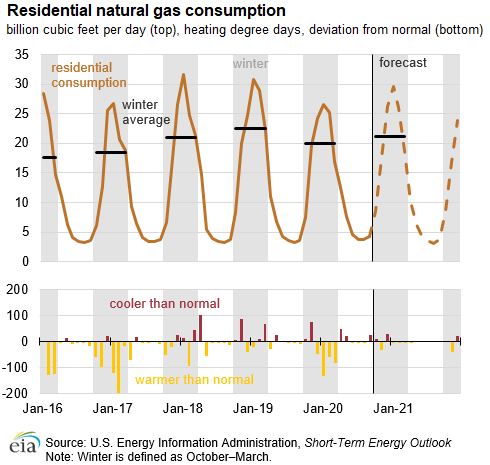
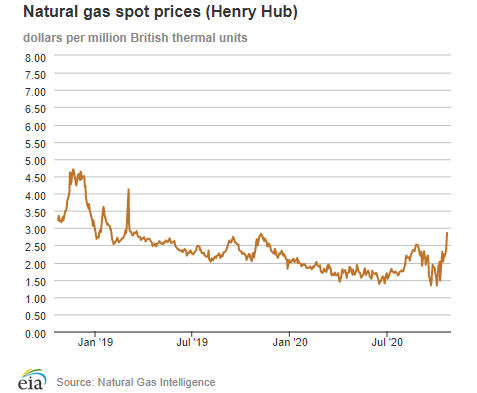
| Spot Prices ($/MMBtu) | Thu, 15-Oct |
Fri, 16-Oct |
Mon, 19-Oct |
Tue, 20-Oct |
Wed, 21-Oct |
|---|---|---|---|---|---|
| Henry Hub |
2.24 |
2.17 |
2.33 |
2.59 |
2.86 |
| New York |
1.49 |
1.29 |
1.28 |
1.48 |
0.91 |
| Chicago |
2.21 |
2.14 |
2.43 |
2.72 |
2.72 |
| Cal. Comp. Avg.* |
3.30 |
3.06 |
3.17 |
3.52 |
3.52 |
| Futures ($/MMBtu) | |||||
| November contract | 2.775 |
2.773 |
2.795 |
2.913 |
3.023 |
| December contract |
3.261 |
3.271 |
3.280 |
3.260 |
3.348 |
| *Avg. of NGI's reported prices for: Malin, PG&E Citygate, and Southern California Border Avg. | |||||
| Source: NGI's Daily Gas Price Index | |||||
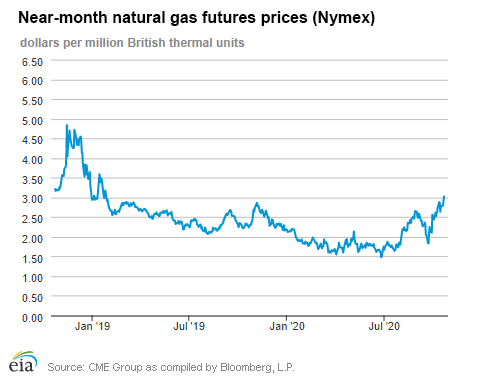
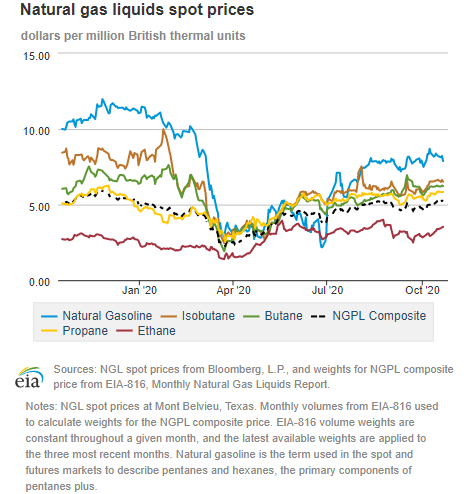
| U.S. natural gas supply - Gas Week: (10/15/20 - 10/21/20) | |||
|---|---|---|---|
Average daily values (Bcf/d): |
|||
this week |
last week |
last year |
|
| Marketed production | 99.8 |
97.2 |
107.5 |
| Dry production | 88.5 |
85.9 |
95.6 |
| Net Canada imports | 3.5 |
4.0 |
4.0 |
| LNG pipeline deliveries | 0.1 |
0.1 |
0.1 |
| Total supply | 92.0 |
90.0 |
99.6 |
|
Source: IHS Markit | |||
| U.S. natural gas consumption - Gas Week: (10/15/20 - 10/21/20) | |||
|---|---|---|---|
Average daily values (Bcf/d): |
|||
this week |
last week |
last year |
|
| U.S. consumption | 67.3 |
62.1 |
66.6 |
| Power | 29.2 |
30.4 |
30.2 |
| Industrial | 21.7 |
20.9 |
21.6 |
| Residential/commercial | 16.4 |
10.8 |
14.8 |
| Mexico exports | 5.9 |
5.9 |
5.5 |
| Pipeline fuel use/losses | 6.7 |
6.5 |
7.2 |
| LNG pipeline receipts | 7.9 |
6.6 |
6.7 |
| Total demand | 87.7 |
81.2 |
86.0 |
|
Source: IHS Markit | |||
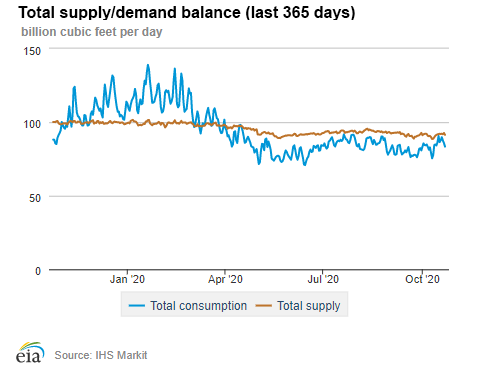
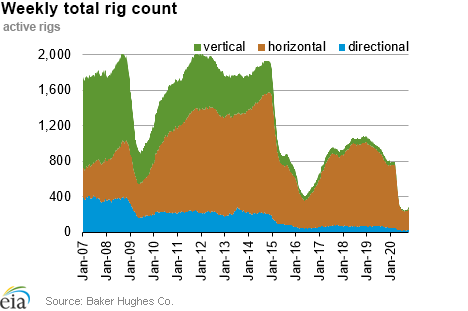
| Rigs | |||
|---|---|---|---|
Tue, October 13, 2020 |
Change from |
||
last week |
last year |
||
| Oil rigs | 205 |
6.2% |
-71.2% |
| Natural gas rigs | 74 |
1.4% |
-46.0% |
| Note: Excludes any miscellaneous rigs | |||
| Rig numbers by type | |||
|---|---|---|---|
Tue, October 13, 2020 |
Change from |
||
last week |
last year |
||
| Vertical | 21 |
40.0% |
-58.8% |
| Horizontal | 240 |
3.0% |
-67.8% |
| Directional | 21 |
0.0% |
-61.8% |
| Source: Baker Hughes Co. | |||
| Working gas in underground storage | ||||
|---|---|---|---|---|
Stocks billion cubic feet (Bcf) |
||||
| Region | 2020-10-16 |
2020-10-09 |
change |
|
| East | 923 |
908 |
15 |
|
| Midwest | 1,105 |
1,081 |
24 |
|
| Mountain | 245 |
241 |
4 |
|
| Pacific | 323 |
320 |
3 |
|
| South Central | 1,329 |
1,326 |
3 |
|
| Total | 3,926 |
3,877 |
49 |
|
|
Source: Form EIA-912, Weekly Underground Natural Gas Storage Report | ||||
| Working gas in underground storage | |||||
|---|---|---|---|---|---|
Historical comparisons |
|||||
Year ago (10/16/19) |
5-year average (2015-2019) |
||||
| Region | Stocks (Bcf) |
% change |
Stocks (Bcf) |
% change |
|
| East | 893 |
3.4 |
889 |
3.8 |
|
| Midwest | 1,062 |
4.0 |
1,039 |
6.4 |
|
| Mountain | 207 |
18.4 |
213 |
15.0 |
|
| Pacific | 297 |
8.8 |
313 |
3.2 |
|
| South Central | 1,122 |
18.4 |
1,144 |
16.2 |
|
| Total | 3,581 |
9.6 |
3,599 |
9.1 |
|
| Source: Form EIA-912, Weekly Underground Natural Gas Storage Report | |||||
| Temperature – heating & cooling degree days (week ending Oct 15) | ||||||||
|---|---|---|---|---|---|---|---|---|
HDD deviation from: |
CDD deviation from: |
|||||||
| Region | HDD Current |
normal |
last year |
CDD Current |
normal |
last year |
||
| New England | 72 |
-21 |
-11 |
0 |
0 |
0 |
||
| Middle Atlantic | 53 |
-28 |
-12 |
0 |
-1 |
0 |
||
| E N Central | 49 |
-36 |
-48 |
1 |
-1 |
1 |
||
| W N Central | 54 |
-28 |
-76 |
8 |
5 |
8 |
||
| South Atlantic | 17 |
-26 |
-11 |
45 |
15 |
9 |
||
| E S Central | 15 |
-26 |
-23 |
22 |
8 |
8 |
||
| W S Central | 4 |
-10 |
-22 |
63 |
29 |
23 |
||
| Mountain | 52 |
-30 |
-61 |
23 |
9 |
12 |
||
| Pacific | 12 |
-16 |
-14 |
24 |
14 |
23 |
||
| United States | 35 |
-26 |
-32 |
23 |
9 |
10 |
||
|
Note: HDD = heating degree day; CDD = cooling degree day Source: National Oceanic and Atmospheric Administration | ||||||||
Average temperature (°F)
7-day mean ending Oct 15, 2020
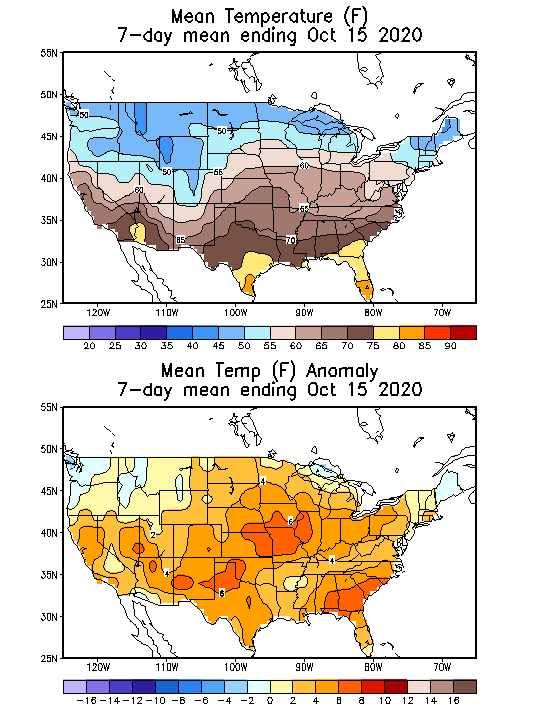
Source: National Oceanic and Atmospheric Administration
Deviation between average and normal (°F)
7-day mean ending Oct 15, 2020

Source: National Oceanic and Atmospheric Administration

